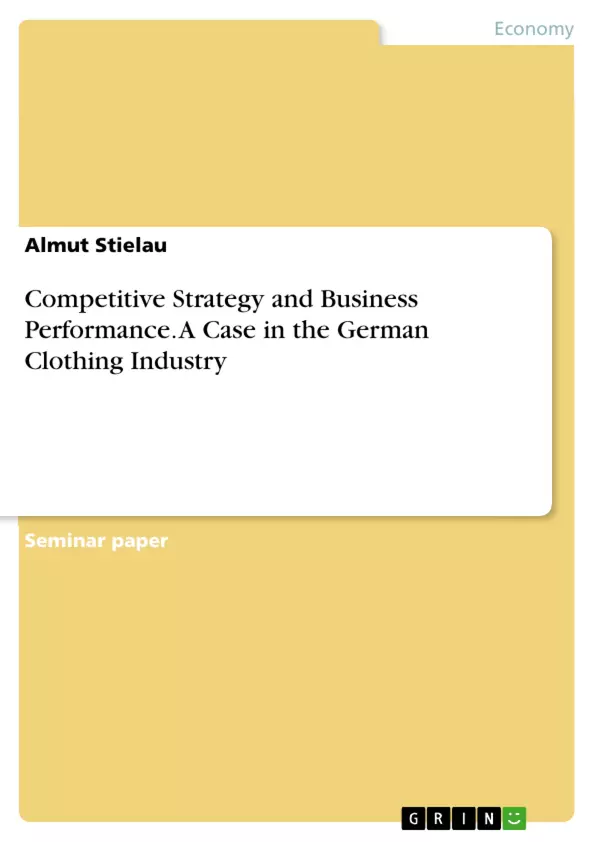The clothing market environment is characterised by strong competition, low demand and declining margins. As prices deflate, many manufacturers are producing premium products. The present paper analyses the German clothing company JIL SANDER AG, which is then compared to BOSS AG and ESCADA AG. Despite their different size they all pursue a similar strategy to survive in a highly competitive surrounding: they built up a strong brand, diversify in other lifestyle segments and distribute their products through own mono-brand shops as well as through franchise partners.
The main task is to assess the performance of a company like Jil Sander in pursuing this strategy, especially considering its size constraints. This is done by qualitative as well as quantitative analysis in view of a environmental analysis, a financial analysis and a scenario analysis
Implementing this strategy, it should be kept in mind that it means less control over franchise partners and factories. The push is on to answer the 'management question' by strengthening the second management level, as a tight control over sales channels will not be possible by the person Jil Sander itself.
Inhaltsverzeichnis (Table of Contents)
- ABSTRACT
- INTRODUCTION
- THE CASE - AN OVERVIEW
- THE GERMAN CLOTHING INDUSTRY
- THE COMPANIES
- Target company: JIL SANDER AG
- Selected competitors: HUGO BOSS AG & ESCADA AG
- QUALITATIVE ANALYSIS
- BROAD CONTEXT: PEST ANALYSIS
- The political environment
- Economic environment
- Social factors
- Technology
- Impact Analysis
- INDUSTRY/SECTOR ANALYSIS: FIVE FORCES
- Intensity of rivalry
- Supplier power
- Distribution channels
- Potential entry
- Substitute products
- COMPANY ANALYSIS: ANSOFF MATRIX
- Current products for current markets
- New products for existing markets
- Current products introduced to new markets
- Diversification of new products for new markets
- BROAD CONTEXT: PEST ANALYSIS
- QUANTITATIVE ANALYSIS
- CHOOSING THE BENCHMARKS
- FIRST GLANCE ON THE FINANCIAL STATEMENTS OF JIL SANDER
- COMMON SIZE STATEMENTS
- Vertical analysis
- Horizontal analysis
- Cross-sectional analysis
- TIME SERIES ANALYSIS AND FINANCIAL RATIOS
- OPERATING RATIOS
- Overall performance
- Working capital
- FINANCIAL RATIOS
- Debt ratios
- Liquidity ratios
- SCENARIO & RECOMMENDATIONS
- DO NOTHING (SHORT-TERM)
- PUSH SALES IN EUROPE (MID-TERM)
- OUTSOURCING PRODUCTION (LONG-TERM)
- BIBLIOGRAPHY
- ANNEX
Zielsetzung und Themenschwerpunkte (Objectives and Key Themes)
This paper analyzes the competitive strategy and business performance of the German clothing company JIL SANDER AG, comparing it to BOSS AG and ESCADA AG. The main objective is to assess the performance of Jil Sander in pursuing its chosen strategy, considering its size constraints. The analysis aims to identify key factors for success in the highly competitive German clothing industry, including the impact of market environment, industry competition, and company-specific factors.
- Analysis of the competitive environment in the German clothing industry
- Assessment of the strategic approaches employed by Jil Sander, BOSS, and ESCADA
- Evaluation of the financial performance of Jil Sander compared to its competitors
- Identification of key success factors and challenges for Jil Sander's future growth
- Development of strategic recommendations for Jil Sander based on the analysis
Zusammenfassung der Kapitel (Chapter Summaries)
The paper begins with an overview of the competitive environment in the German clothing industry, characterized by declining sales and intense competition. It highlights the challenges faced by apparel manufacturers and identifies key success factors. The analysis then focuses on Jil Sander, comparing its strategy and performance to those of BOSS and ESCADA.
The qualitative analysis examines the broader context of the industry using a PEST analysis, assessing political, economic, social, and technological factors. It also analyzes the industry structure using Porter's Five Forces model, examining competitive rivalry, supplier power, distribution channels, potential entry, and substitute products. The company analysis utilizes Ansoff's matrix to evaluate Jil Sander's strategic options for growth.
The quantitative analysis focuses on the financial performance of Jil Sander, comparing its key financial ratios and common size statements to its competitors. It assesses the company's profitability, debt levels, and liquidity.
Based on the analysis, the paper presents three strategic scenarios for Jil Sander: doing nothing, pushing sales in Europe, and outsourcing production. The scenarios are evaluated based on their potential impact on the company's financial performance and competitive position.
Schlüsselwörter (Keywords)
The primary focus of the study is on the German clothing industry, competitive strategy, business performance, brand management, financial analysis, and strategic recommendations. Key concepts include PEST analysis, Porter's Five Forces model, Ansoff's matrix, common size statements, financial ratios, and scenario planning.
- Arbeit zitieren
- Almut Stielau (Autor:in), 1999, Competitive Strategy and Business Performance. A Case in the German Clothing Industry, München, GRIN Verlag, https://www.hausarbeiten.de/document/299255


